What makes Sabong, a traditional sport in the Philippines, so important? It deeply affects the country’s culture and economy. Sabong, or cockfighting, has been a part of Filipino life for centuries. It has its own rules and regulations.
As we explore Sabong, we see it’s more than just a sport. It’s a way of life that includes breeding, training, and caring for fighting cocks. To learn more about Sabong’s history and cultural importance, visit Filipino culture and tradition. Discover the rich heritage behind this beloved sport.
Key Takeaways
- Sabong is a traditional sport in the Philippines that involves cockfighting.
- It has a significant impact on the country’s culture and economy.
- Sabong involves breeding, training, and caring for fighting cocks.
- It is a way of life that is deeply rooted in Filipino tradition.
- Sabong has its own set of rules and regulations.
- It is a popular sport that is enjoyed by many Filipinos.
Introduction to Sabong
Sabong, a form of cockfighting, has a long history in the Philippines. It dates back to the pre-colonial era. Over time, it has evolved, influenced by cultures like the Spanish who introduced their own version.
Today, sabong is a big part of Filipino culture. It has a large following and a significant economic impact.
The cultural importance of sabong in Filipino society is huge. It’s not just a sport but a social activity that brings people together. Cockfighting is a tradition passed down through generations, with many Filipinos involved or attending events.
Historical Background of Cockfighting in the Philippines
The history of cockfighting in the Philippines is rich and complex. It started in 1521 during Magellan’s voyage. Over time, sabong became a big part of Filipino tradition and culture. Many breeds of fighting cocks were bred for their strength and stamina.
Cultural Significance of Sabong in Filipino Society
Sabong is more than a sport; it’s a way of life for many Filipinos. The culture around sabong is vibrant and diverse. Many events and festivals are centered around cockfighting.
The sport has also had a big impact on the economy, mainly in rural areas. It provides income for breeders, trainers, and event organizers.
- Cockfighting is a centuries-old tradition, with documented evidence in ancient civilizations such as Persia, India, and Southeast Asia.
- Sabong has a notable economic impact, mainly in rural areas, providing income for breeders, trainers, and event organizers.
- The digital era has brought a new dimension to cockfighting, with e-Sabong allowing for remote participation and betting on fights through online platforms.
Rules and Regulations of Sabong
Sabong is a traditional Filipino sport with its own rules. These rules change based on the region and the type of cockfight. Generally, Sabong has rules for the fight’s conduct, like the size and weight of the cocks, fight length, and betting rules.
For more information on Filipino culture and traditions, visit this website to learn about the ancient Filipino script of Baybayin.
Overview of Cockfighting Rules
The rules of Sabong aim for a fair and safe fight. They include the use of gaffs, sharp blades on the cock’s leg, and a referee to oversee the fight.
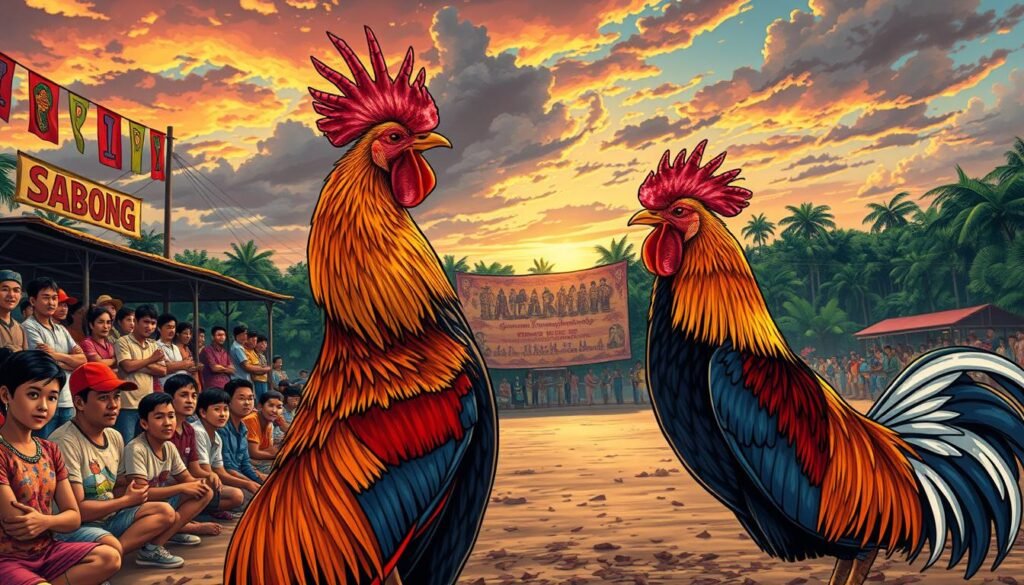
Licensing and Regulation in Different Regions
Licensing and regulation of Sabong vary by region. In the Philippines, the Games and Amusements Board regulates Sabong. To get a license, operators need a minimum of 50 Million Pesos in capital stock and 12.5 Million Pesos paid-up capital.
Understanding Sabong’s rules is key to its integrity and safety. This knowledge helps both participants and spectators enjoy the sport’s complexity and excitement.
Types of Fighting Cocks
Sabong, the traditional Filipino cockfighting, features many breeds of fighting cocks. Each breed has its own strengths and characteristics. Breeding is key in developing these breeds for the cockpit.
The Asil is known for its power and aggression. The Hatch is valued for its endurance and stamina. The Modern Game is popular for its speed and agility. Breeding aims to create fighting cocks that excel in the cockpit, showing strength, speed, and cunning.
Here are some key breeds of fighting cocks in Sabong:
- Asil: Powerful and aggressive
- Hatch: Enduring and stamina-rich
- Modern Game: Fast and agile
- Kelso: Intelligent and tactical
- Sweater: Hardy and durable
These breeds are highly valued in Sabong for their unique traits and abilities. Breeding and training are complex, needing a deep understanding of genetics, nutrition, and conditioning. This is how champions are made.
https://www.youtube.com/watch?v=0rwvj5R4Oeg&pp=ygUJI2tvY2t0aXBz
In Sabong, the quality of fighting cocks is essential. Breeding is the key to unlocking their full strength. By knowing the characteristics of different breeds, fans can appreciate the complexity and richness of this traditional Filipino sport.
| Breed | Characteristics | Role in Sabong |
|---|---|---|
| Asil | Powerful, aggressive | Excels in strength and combat |
| Hatch | Enduring, stamina-rich | Performs well in long matches |
| Modern Game | Fast, agile | Excels in speed and quick reflexes |
Sabong Events and Tournaments
Sabong events and tournaments are a big part of Filipino culture. Over 70% of rural communities join in. These events are fun and help people come together.
They draw big crowds, with up to 500 people coming each week. The atmosphere is lively and festive.
Planning these events takes a lot of work. Cockfighters, promoters, and government agencies all play a role. They work together to make sure the competition is fair and safe.
Some famous events include the Bakbakan National Derby and the World Slasher Cup. The World Slasher Cup is called the “Olympics of Cockfighting”.
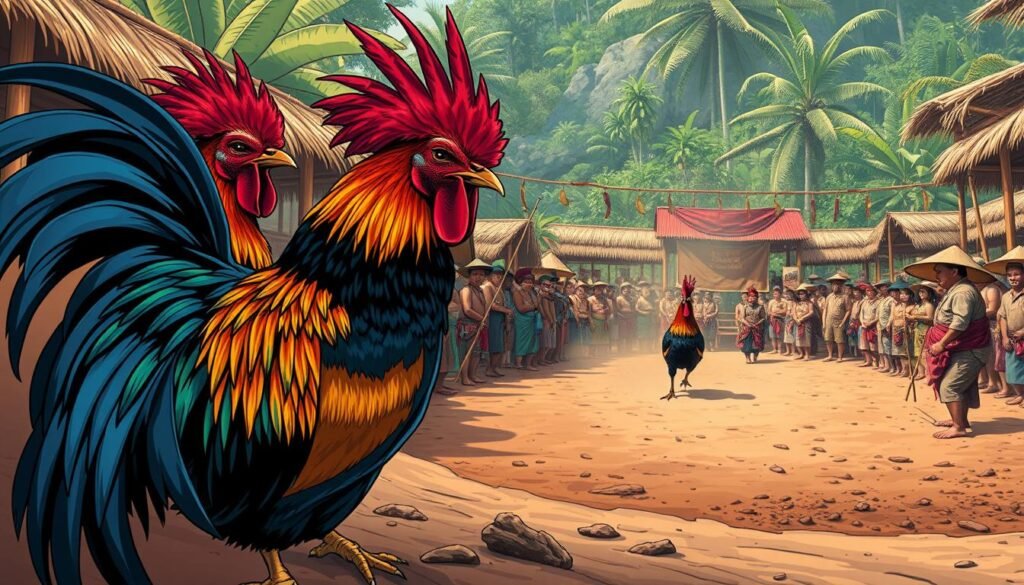
These events offer more than just cockfighting. There are breeder exhibitions and educational seminars too. Pitmasters Live hosts regular tournaments with live broadcasts and betting.
Online Sabong tournaments are also popular. They let fans from all over the world join in.
| Event | Description |
|---|---|
| Bakbakan National Derby | A large-scale Sabong event with over a thousand entries |
| International Gamefowl Festival | A festival featuring tournaments, breeder exhibitions, and educational seminars |
| World Slasher Cup | A prestigious Sabong tournament often referred to as the “Olympics of Cockfighting” |
In conclusion, Sabong events and tournaments are key in Filipino culture. They offer fun, socialization, and a chance to build community. With online platforms, these events are now easier for fans worldwide to enjoy.
The Role of Technology in Sabong
Sabong, a traditional Filipino sport, has changed a lot with technology. Now, you can bet and watch Sabong fights online. This has made Sabong more popular and easy to access.
Technology has also improved how we breed and train fighting cocks. We use genetic testing and other advanced methods. This helps make the cocks better fighters.
The online Sabong market has grown a lot, with a 464.38% increase in 2024. This growth has made traditional casino owners start their own online sites. But, technology has also raised questions about Sabong’s legality and ethics. Some operators have been arrested for illegal activities.

Digital Platforms for Betting and Streaming
Digital platforms have changed how we enjoy Sabong. Now, you can bet and watch fights online. This has made Sabong more popular, even among the young.
Platforms like online gaming sites and mobile apps make it easy to get into Sabong. They offer a convenient way to enjoy the sport.
Innovations in Breeding and Training
Technology has also brought new ways to breed and train fighting cocks. We use genetic testing and other advanced methods. These aim to make the cocks better and more competitive.
As technology keeps improving, it will be exciting to see how Sabong evolves. It will be interesting to see how the sport adapts to new technologies.
The Economic Impact of Sabong
Sabong has a big impact on the economy, mainly in rural areas. It is a key source of income for many. It creates jobs for cockfighters, breeders, and promoters.
Related industries like feed and equipment suppliers also gain. The Philippine Amusement and Gaming Corporation (PAGCOR) expects e-sabong revenue to hit P7.2 billion in 2022. This money will fund important programs for the country.
The local gaming industry employs about 132,000 Filipinos. E-sabong operators want 25-year licenses to help the economy grow and create more jobs. The revenue from e-sabong will help reduce the budget deficit to 3.7 percent by 2028.

Here are some key statistics highlighting the economic impact of Sabong:
- PAGCOR collected over P80 billion in 2019, which decreased to less than P30 billion in 2020.
- E-sabong operators are granted 25-year franchises to operate, such as Lucky 8 Star Quest Inc.
- PAGCOR coordinates with government agencies to combat scams and unauthorized activities in online gambling.
In conclusion, Sabong has a big economic impact. It helps create jobs and supports related industries. Its revenue will also fund important programs for the country.
| Year | PAGCOR Revenue | E-sabong Revenue |
|---|---|---|
| 2019 | P80 billion | N/A |
| 2020 | Less than P30 billion | N/A |
| 2022 | N/A | P7.2 billion |
Legal and Ethical Controversies Surrounding Sabong
Sabong, a traditional Filipino sport, has raised many legal and ethical issues. It involves live animals for entertainment, leading to debates on animal welfare. The legal status of Sabong in the Philippines is debated, with some calling for a ban due to animal cruelty.
The Philippine government has set rules for Sabong, with Pagcor overseeing online Sabong. Yet, illegal Sabong operations are a big problem. They cause huge losses in taxes and licensing fees for the government.
Animal Welfare Concerns
Animal welfare is a big concern in Sabong. Cockfights can hurt or kill animals. Many question the ethics of Sabong, saying it promotes animal cruelty and should be banned.
Legal Status of Sabong in the Philippines
The legal status of Sabong in the Philippines is complex. While it’s legal and regulated, there are ongoing debates about its ethics and legality. Here are some key points about Sabong’s legal status:
- Cockfighting is legal and regulated in the Philippines, with many cockpits nationwide where fans watch and celebrate.
- The Philippine Amusement and Gaming Corp. (Pagcor) regulates online Sabong to protect players and ensure the government gets its share of revenue.
- The Department of the Interior and Local Government (DILG) has launched a crackdown on illegal Sabong operations, following reports of violations.
The Sabong industry is a big part of the Philippine economy, worth around P50 billion a year. It provides jobs for millions, from breeding roosters to running cockfighting events. It also supports jobs in canteens, parking, and public transport.
Sabong as a Traditional Sport
Sabong is a traditional Filipino sport that has been part of our culture for centuries. It’s a social activity that brings people together. It gives them a sense of community and belonging.
The sport is deeply rooted in Filipino heritage. Preserving Sabong is key to keeping our cultural identity alive.
Community Engagement and Social Bonds
At the heart of Sabong is the community that comes together. It’s a sport that fosters social bonds among its fans. This creates a sense of camaraderie and shared tradition.
Key aspects of Sabong’s community engagement include:
- Regular events and tournaments that bring people together
- A shared passion for the sport that transcends social classes
- A platform for social interaction and bonding among enthusiasts
Preservation of Filipino Heritage Through Sabong
Sabong plays a significant role in preserving Filipino heritage. It’s a sport with traditions and customs passed down through generations. It’s a testament to the country’s rich cultural history.
By embracing Sabong, Filipinos can celebrate their heritage and cultural traditions. The sport’s significance goes beyond entertainment. It serves as a symbol of national pride and a connection to our history.
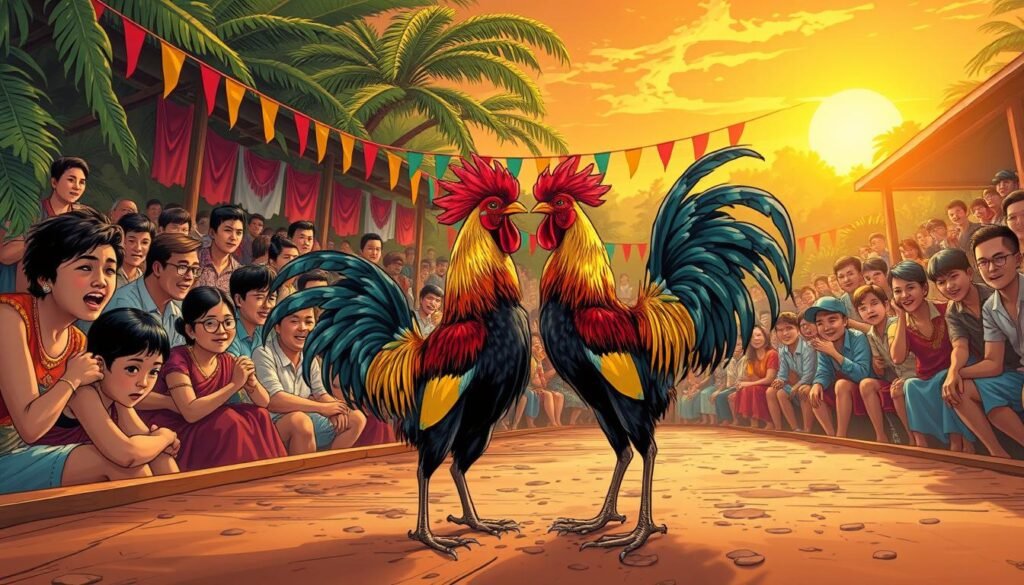
By embracing Sabong as a traditional sport, Filipinos can celebrate their heritage and cultural traditions. The sport’s significance goes beyond entertainment. It serves as a symbol of national pride and a connection to our history.
| Aspect of Sabong | Importance to Filipino Heritage |
|---|---|
| Community Engagement | Fosters social bonds and a sense of belonging |
| Tradition and Customs | Preserves cultural history and national identity |
| Cultural Significance | Represents Filipino pride and connection to the past |
Gambling and Betting Practices
Gambling and betting are big parts of Sabong. Many people bet on the fight outcomes. The odds start at ten percent and can reach one hundred percent for the favorite rooster.
A ten percent fee is taken from the bet total. Also, a ten percent tip on winnings is common.
There are different bets in Sabong, like win/loss, point spread, and over/under. Research shows gambling’s psychological side is key Betting amounts are shown by fingers, with ten for one finger, hundreds for two, and thousands for three.
Types of Betting in Sabong Events
The types of bets in Sabong are:
- Win/loss betting: betting on the fight winner
- Point spread betting: betting on the victory margin
- Over/under betting: betting on the total rounds
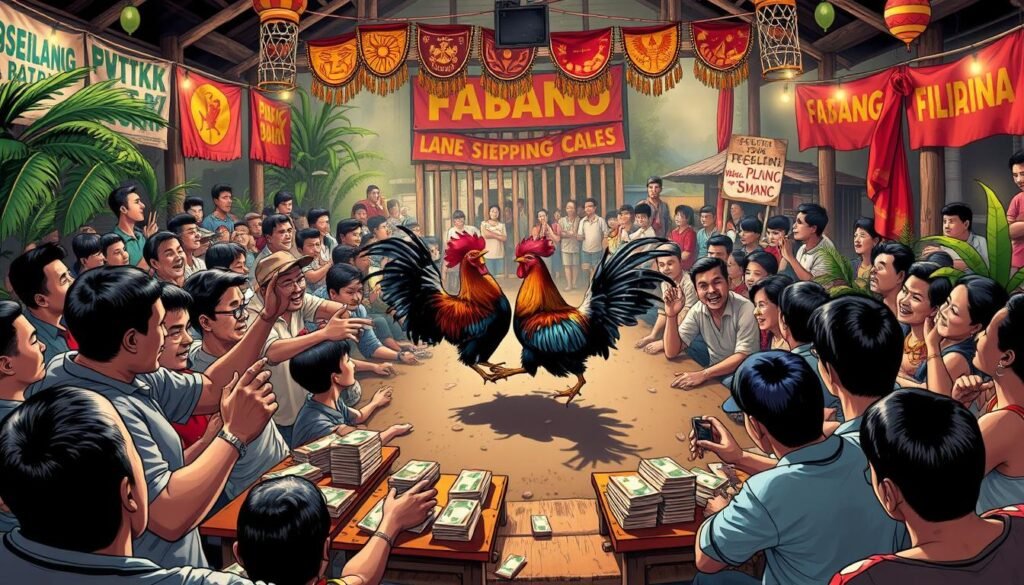
The Psychological Aspect of Gambling
The psychology of gambling is complex. It involves risk, excitement, and social interaction. Gambling can be addictive.
It’s vital to know the risks. The implied probability for a bet can be found using a formula.
Social Perceptions of Sabong
The way people view Sabong changes based on their age, gender, and social status. Younger folks are more critical, worried about animal welfare and society’s well-being. A survey by the DILG found 62% want to stop e-Sabong, 34% want rules tightened, and 4% fully support it.
This change in social perception is big. It shows a shift in how people see Sabong.
The study on cultural facets in the Philippines shows Sabong has been around for ages. But now, many want it banned because of animal cruelty. People are talking more about Sabong and its effects on society.
Changing Attitudes Among Younger Generations
Younger people see Sabong as cruel and old-fashioned. This is clear in the survey, where most want e-Sabong stopped. The changing social perception of Sabong shows growing concern for animal welfare and society’s well-being.
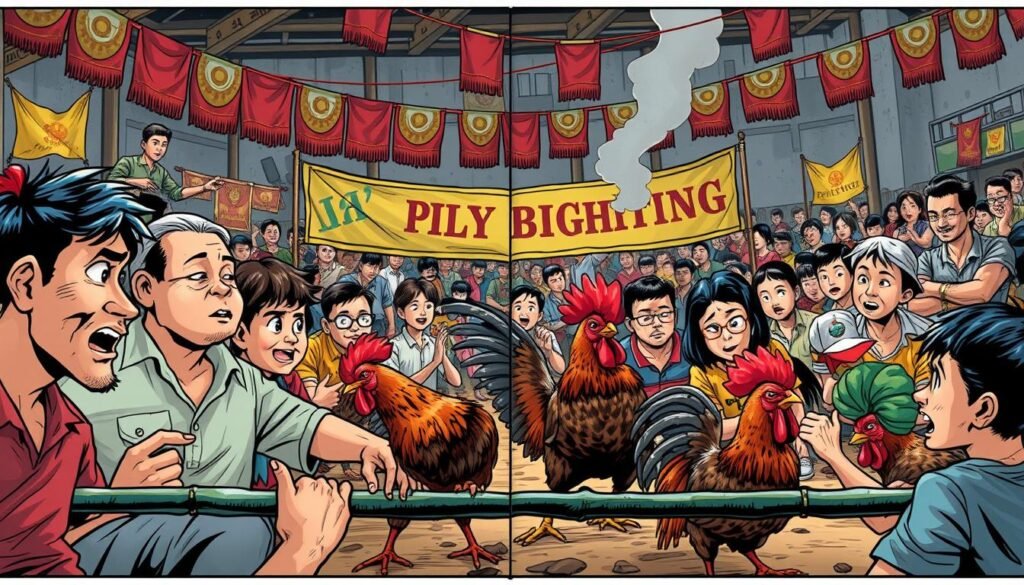
Public Discourse on Cockfighting
People are talking more about cockfighting, sharing their views on Sabong. Views on Sabong are mixed. Some see it as a tradition, while others call it cruel and outdated. As opinions on Sabong evolve, it will likely face more criticism.
The Future of Sabong
The future of Sabong is tied to its evolution as a sport and industry. Online cockfighting, or E-Sabong, has become very popular. It made P6.2 billion from April 2021 to April 2022. This growth is expected to keep going, thanks to new tech like Virtual Reality (VR) and Augmented Reality (AR).
Reports say Artificial Intelligence (AI) and Blockchain technology are becoming key. They help make matches fair and betting safe. The use of cryptocurrencies like Bitcoin and Litecoin is also increasing. These changes show the sport is always getting better.

But, Sabong faces challenges too. Animal welfare and social issues are big concerns. Bishop Pablo Virgilio David has spoken out about these problems. Yet, many fans keep enjoying and betting on Sabong.
The sport’s future will depend on how it handles these issues. It must find ways to keep growing and caring for animals. This will ensure Sabong’s long-term success.
For more on the Philippines’ history and infrastructure, visit this website. Sabong’s future will be shaped by its ability to adapt and care for animals.
Sabong in Popular Culture
Sabong, a traditional Filipino sport, has deeply influenced the country’s culture. It’s often seen in film and media, showing its big role in Filipino life. For example, movies have highlighted its cultural value and the fans’ passion.
The sport’s impact is also seen in media like books and art. These works show Sabong’s strong place in Filipino culture. It makes the country’s heritage special and unique.
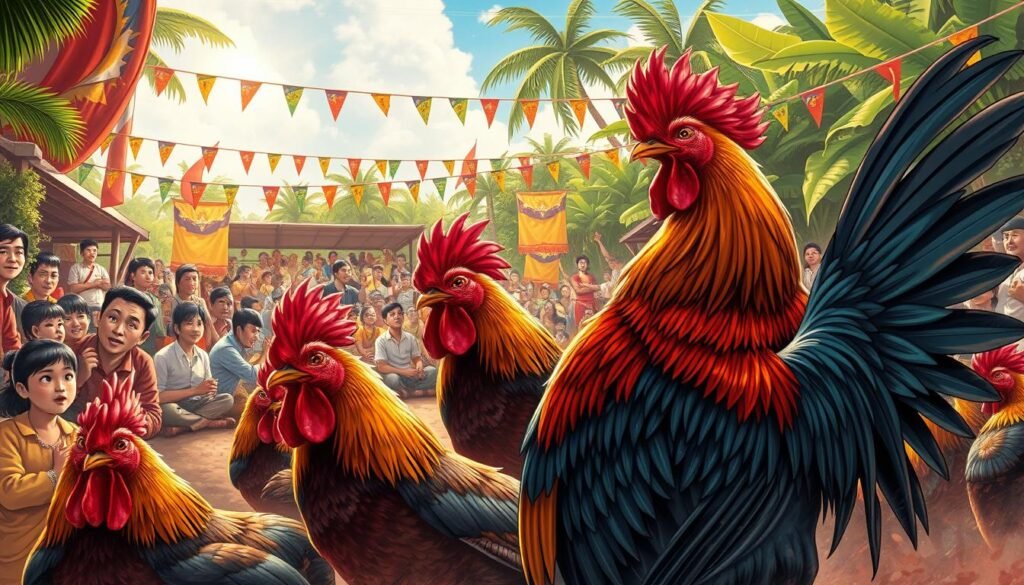
Sabong’s effect on culture is clear in media like TV and online. Its wide presence has kept it popular. It’s now a key part of Filipino popular culture.
| Form of Media | Representation of Sabong |
|---|---|
| Film | Featured in films, showing its cultural importance |
| Literature | Has inspired many books, showing its cultural impact |
| Art | Has influenced art, showing its special place in heritage |
In conclusion, Sabong’s impact on Filipino popular culture is clear. Its presence in media has made it more popular. As a big part of the country’s culture, Sabong keeps inspiring and drawing in people, making it a beloved part of Filipino society.
Health and Safety Considerations in Sabong
Sabong, a traditional Filipino cockfighting activity, needs careful health and safety steps. Regular veterinary care is key for the fighting cocks. This includes check-ups and medical treatment for injuries. The Department of the Interior and Local Government (DILG) in the Philippines has guidelines for safe cockfighting.
These guidelines say sabong operations must follow health rules. This means limiting venue capacity and requiring vaccination for workers. It also includes cashless betting and enforcing mask-wearing and physical distancing.
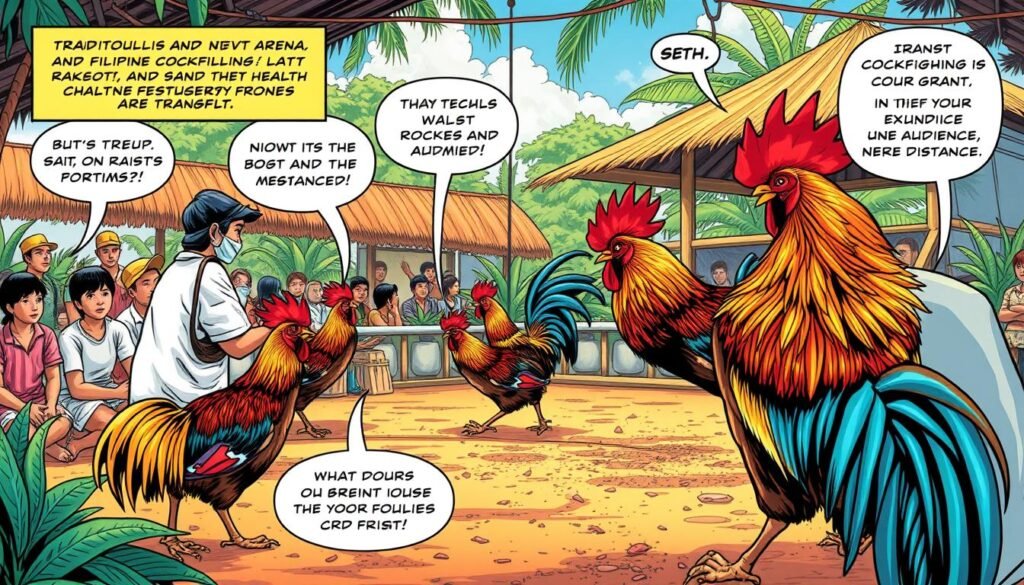
- Wearing protective gear, such as masks and gloves
- Implementing emergency procedures, such as first aid kits and emergency exits
- Ensuring proper ventilation and sanitation in the venue
By focusing on health and safety, sabong can be enjoyed safely. This reduces the risk of injury or illness for both humans and animals.
Sabong and Community Identity
Sabong is key in forming community identity, mainly in rural areas. It’s a big source of fun and socializing. It brings people together to celebrate their culture, creating a strong sense of community.
In these areas, Sabong is more than just fun. It’s a big part of their identity. It helps people connect with their roots and keep their traditions alive. The community comes together for Sabong events, making social bonds stronger and unity more evident.
Representation of Local Cultures
Sabong shows off the local culture and identity of the communities involved. It’s tied to traditional practices and customs, passed down through generations. By joining Sabong, people can connect with their heritage and help keep local traditions alive.
Sabong as a Gathering Space
Sabong events are places where the community comes together. They’re for socializing and celebrating shared identity. Sabong is a way to meet new people, build relationships, and strengthen bonds. It’s not just entertainment; it’s a way to unite people.
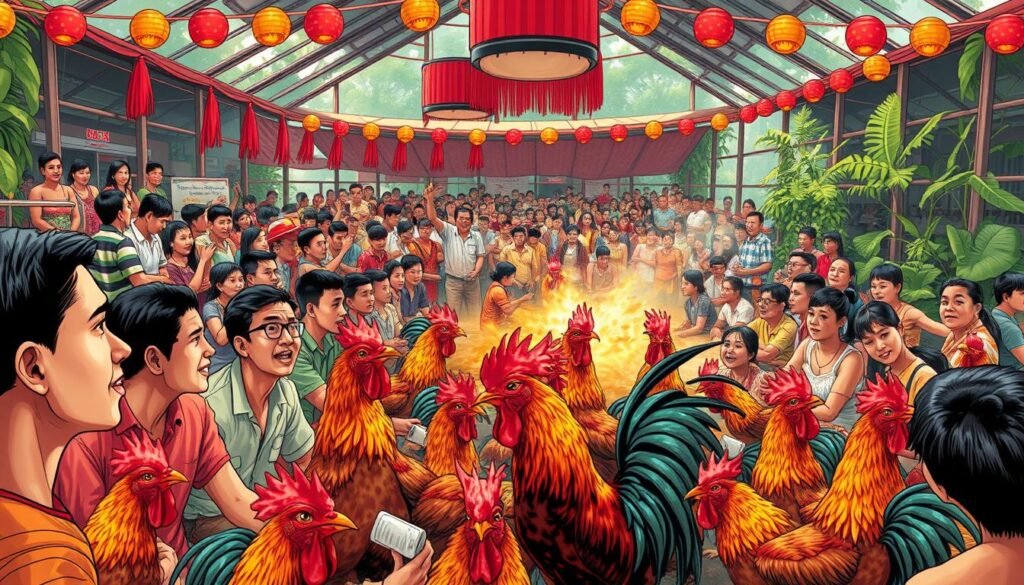
| Aspect | Role of Sabong |
|---|---|
| Community Building | Fosters social bonds and unity |
| Cultural Preservation | Preserves traditional practices and customs |
| Identity Formation | Shapes the identity of communities |
International Perspectives on Cockfighting
Cockfighting, known as Sabong in the Philippines, is a global issue. It has different views around the world. In the Philippines, Sabong is seen as a cultural and traditional value. But, its view changes in other countries.
In places like Mexico and Spain, cockfighting is legal and part of their culture. But, in the UK and the US, it’s banned because of animal cruelty worries. International perspectives show how complex this issue is. Each country has its own rules and laws.
Sabong is unique compared to other cockfighting forms. Learning from other countries is important. They teach us about animal welfare and the need for rules and checks. Here are some countries with their own ways of dealing with cockfighting:
- Indonesia: Cockfighting is illegal everywhere except in Bali for religious reasons.
- Vietnam: It’s officially banned but is a big part of rural culture.
- France: It’s allowed in some areas because of historical reasons.
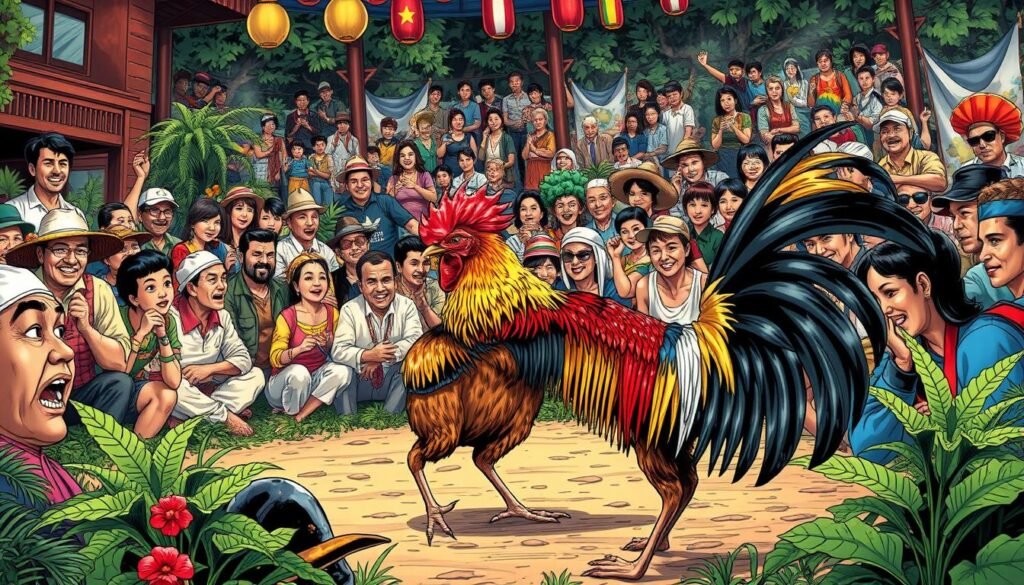
Looking at international perspectives on cockfighting helps us understand Sabong better. It shows the cultural importance of Sabong in the Philippines. It also shows how it can grow and improve.
| Country | Cockfighting Status | Cultural Significance |
|---|---|---|
| Philippines | Legal and regulated | Deeply rooted in culture and tradition |
| Mexico | Legal in several states | Intertwined with cultural practices and local economies |
| United Kingdom | Banned | Viewed as animal cruelty |
Conclusion
As we wrap up our look into Sabong, it’s obvious that this traditional Filipino cockfighting sport is deeply ingrained in the country’s culture. Despite the ethical debates and legal hurdles, Sabong remains a cherished tradition. It brings people together, crossing social lines and uniting Filipino communities.
The future of Sabong looks promising, with technology and changing views shaping its path. Online platforms have made the sport more accessible, drawing in a wider audience. This has opened up new chances for breeders and fans. Yet, the industry must tackle the challenges of regulation and animal welfare to stay relevant and sustainable.
Looking forward, Sabong will likely remain a subject of debate. Both supporters and critics will continue to share their views on its place in today’s Filipino society. At its core, Sabong connects people, keeps cultural heritage alive, and fosters a sense of community and shared identity.
FAQ
What is Sabong, and how is it connected to Filipino culture?
Sabong, or Filipino cockfighting, is a traditional sport in the Philippines. It involves breeding, training, and fighting cocks. This sport is deeply rooted in Filipino culture.
What is the history of Sabong in the Philippines?
Sabong has been part of Filipino culture for centuries. It started before the Spanish colonizers arrived. They introduced their version of cockfighting, which evolved into the Sabong we know today.
What are the rules and regulations governing Sabong?
Sabong rules vary by region and type of fight. They cover the size and weight of the cocks, fight length, and betting rules. Licensing and regulations also differ across areas.
What are the most popular breeds of fighting cocks used in Sabong?
Popular breeds include the Asil, Hatch, and Modern Game. These are chosen for their strength, speed, and agility in the cockpit.
What are the major Sabong events and tournaments held in the Philippines?
Major events are held throughout the year. They bring together top cockfighters and their birds. These events showcase skills and offer prizes.
How has technology impacted the Sabong industry?
Technology has changed Sabong, mainly in betting and streaming. Online betting and live streaming are now common. It has also improved breeding and training through genetic testing and other techniques.
What is the economic impact of Sabong in the Philippines?
Sabong boosts local economies, creating jobs for many. It includes cockfighters, breeders, and promoters. Related industries like feed suppliers also benefit.
What are the legal and ethical concerns surrounding Sabong?
Sabong raises ethical and legal issues. Animal welfare is a major concern. The sport’s legality in the Philippines is also debated, with some calling for a ban.
How is Sabong represented in popular culture?
Sabong appears in films, literature, and art. Movies like “Cockfighter” and “The Cockpit” feature it. Literary works and art also draw inspiration from Sabong.
How does Sabong contribute to community identity and social bonds in the Philippines?
Sabong strengthens community identity, mainly in rural areas. It’s a source of entertainment and social interaction. It brings people together to celebrate their culture.
Source Links
- Ateneo Ethnographies – https://thehappyandgayexperience.wordpress.com/page/5/
- Exploring the Participation of Local Community Members with Sulubaaï Environmental Foundation in Pangatalan Island, Palawan – https://www.academia.edu/52775068/Exploring_the_Participation_of_Local_Community_Members_with_Sulubaai_Environmental_Foundation_in_Pangatalan_Island_Palawan
- Cockfighting – https://en.wikipedia.org/wiki/Cockfighting
- The Tradition and Culture of Sabong (Cockfighting) – jbms360 – https://jbms360.com/the-tradition-and-culture-of-sabong-cockfighting/
- SABONG / COCKFIGHTING 101 / Philippines for the Intrepid Traveler / BY GODOFREDO U. STUART JR – https://www.stuartxchange.org/Sabong
- MEMORANDUM – https://www.pagcor.ph/regulatory/pdf/esabong/esabong-regulatory-framework.pdf
- Ultimate Guide to 15 Best Fighting Rooster and Gamefowl Breeds – https://www.asiafarming.com/ultimate-guide-to-15-best-fighting-rooster-and-gamefowl-breeds
- Philippines Birds – https://philippinesbirds.com/
- Sabong tournaments are admired by Filipinos 2024 – https://anfieldindex.com/70063/sabong-tournaments-are-admired-by-filipinos-2024.html
- Popular Online Sabong Tournaments You Should Follow – https://sabongonlineph.com/popular-online-sabong-tournaments-2024/
- E-Sabong: Cockfighting’s Billion-Peso Pandemic Response Measure – https://mediacommoner.medium.com/e-sabong-cockfightings-billion-peso-pandemic-response-measure-2e7298956e86
- From e-sabong to e-games craze – https://www.philstar.com/opinion/2025/01/05/2411865/e-sabong-e-games-craze
- PNP seeks help of tech-linked gov’t agencies vs. ‘e-sabong’ – https://www.pna.gov.ph/articles/1192812
- Weighing in on the effects of regulating e-sabong in PHL – https://thelasallian.com/2022/02/28/weighing-in-on-the-effects-of-regulating-e-sabong-in-phl/
- Labor group cites social costs of e-sabong revival – https://www.pna.gov.ph/articles/1232151
- Sabong as a Cultural Phenomenon in the Philippine Society – Yucatán Magazine – https://yucatanmagazine.com/sabong-as-a-cultural-phenomenon-in-the-philippine-society/
- Meron! Meron! Constructing the Nature of Man in Sabong (Cockfighting) – https://www.scirp.org/journal/paperinformation?paperid=125243
- Cockfighting (Sabong) – https://thehappyandgayexperience.wordpress.com/2019/05/13/cockfighting-sabong/
- Sabong, “The Sport of Kings” – http://thingsasian.com/story/sabong-“-sport-kings”
- Gambling in the Philippines – https://en.wikipedia.org/wiki/Gambling_in_the_Philippines
- Sabong Betting System – Traveler on Foot – https://traveleronfoot.wordpress.com/tag/sabong-betting-system/
- The Math Behind Betting Odds & Gambling – https://www.investopedia.com/articles/dictionary/042215/understand-math-behind-betting-odds-gambling.asp
- DILG orders crackdown on illegal e-Sabong operations – https://calabarzon.dilg.gov.ph/dilg-orders-crackdown-on-illegal-e-sabong-operations/
- International Journal of Education Humanities and Social Science – https://ijehss.com/uploads2022/EHS_5_454.pdf
- The greater evil: Pogo or ‘e-sabong’ – https://opinion.inquirer.net/175960/the-greater-evil-pogo-or-e-sabong
- The Future of Virtual Sabong: Innovations and Advancements – https://journal.com.ph/the-future-of-virtual-sabong-innovations-and-advancements/
- Why Sabong is More Than a Game in the Philippines – https://getitrent.com/js/pgs/why_sabong_is_more_than_a_game_in_the_philippines.html
- SABONG: A Form of Expression and Beyond – https://flaringcherryblossom.wordpress.com/2012/10/18/sabong-a-form-of-expression-and-beyond/
- PDF – https://www.pagcor.ph/regulatory/pdf/esabong/esabong-regulatory-framework-e-sabong-off-cockpit-betting-station.pdf
- Microsoft Word – QCG Memo – Resived GCQ Oct 20.doc – https://quezoncity.gov.ph/wp-content/uploads/2021/03/Supplemental-GCQ-Guidelines-14Mar21.pdf?fbclid=IwAR3wNxeTde30LDHndOkyysph43TeU8Bm4r-HKplc4khxTYOuNBL_0gA4v2Q
- Some ‘e-sabong’ operators still dodging Duterte ban – https://newsinfo.inquirer.net/1599465/some-e-sabong-operators-still-dodging-duterte-ban
- 2021–2022 Luzon sabungero disappearances – https://en.wikipedia.org/wiki/2021–2022_Luzon_sabungero_disappearances
- Pagcor taps e-sabong to shore up revenue – https://www.philstar.com/headlines/2021/05/03/2095523/pagcor-taps-e-sabong-shore-revenue
- Cockfighting Around the World: Historical, Cultural, and Legal Peculiarities – https://theedinburghreporter.co.uk/2023/11/cockfighting-around-the-world-historical-cultural-and-legal-peculiarities/
- Cockfighting in the Philippines: What it was like – Earth Vagabonds – https://www.earthvagabonds.com/cockfighting-in-the-philippines-what-it-was-like/
- Sabong: A Microcosm of the Contemporary World – https://thehappyandgayexperience.wordpress.com/2019/12/02/sabong-a-microcosm-of-the-contemporary-world/
- Answers to: Write an essay about Give your insights about Online Sabong. – https://www.classace.io/answers/write-an-essay-about-give-your-insights-about-online-sabong
- Marcos continues ban on e-sabong operations – BusinessWorld Online – https://www.bworldonline.com/the-nation/2022/12/29/495913/marcos-continues-ban-on-e-sabong-operations/

